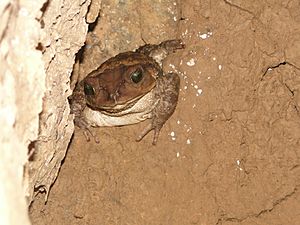Western giant toad facts for kids
Quick facts for kids Western giant toad |
|
|---|---|
 |
|
| Conservation status | |
| Scientific classification | |
| Synonyms | |
|
The western giant toad (Peltophryne fustiger) is a type of toad that belongs to the Bufonidae family, which is a group of true toads. This special toad is only found in western Cuba. It lives in many different places, like thick forests, grassy areas, savannas, and even farms. The western giant toad is a common animal, but sometimes its home can be destroyed, which makes it harder for them to survive in certain spots.
Contents
About the Western Giant Toad
The western giant toad is a fascinating amphibian. It was first described in 1960 by a scientist named Albert Schwartz. These toads are known for their size, which is why they are called "giant." Like all toads, they are amphibians, meaning they can live both on land and in water.
Where Do Western Giant Toads Live?
These toads are special because they are endemic to western Cuba. This means you won't find them naturally anywhere else in the world! They are very adaptable and can live in many different environments.
They make their homes in various places, including:
- Broadleaf forests: These are forests with trees that have wide, flat leaves.
- Grasslands: Open areas covered mostly by grasses.
- Savannas: Areas with scattered trees and tall grasses.
- Agricultural areas: Places where people grow crops or raise animals.
This ability to live in many different habitats helps them survive.
What Do Western Giant Toads Look Like?
Western giant toads have the typical appearance of a toad. They usually have bumpy skin and a wide body. Their skin helps them blend into their surroundings, protecting them from predators. The exact colors can vary, but they often have earthy tones like brown, gray, or olive green. This camouflage helps them hide among leaves and dirt.
Life Cycle of a Toad
Like other amphibians, western giant toads go through a process called metamorphosis. This means they change a lot as they grow up.
- Eggs: Toads start their lives as eggs, usually laid in water.
- Tadpoles: The eggs hatch into tadpoles, which are like tiny fish. Tadpoles live in water and breathe with gills. They eat plants and algae.
- Young Toads: As they grow, tadpoles develop legs and their tails get shorter. They also start to develop lungs to breathe air.
- Adult Toads: Eventually, they become adult toads, ready to live on land. They will then find mates and lay their own eggs, continuing the cycle.
What Do Western Giant Toads Eat?
Adult western giant toads are carnivores, which means they eat other animals. They are not picky eaters and will often eat any small creature they can catch. Their diet usually includes:
- Insects: Like beetles, crickets, and flies.
- Spiders: Eight-legged creatures that spin webs.
- Worms: Soft-bodied invertebrates.
- Other small invertebrates: Such as slugs or snails.
They use their long, sticky tongues to catch their prey quickly.
How Are Western Giant Toads Protected?
The western giant toad is listed as "Least Concern" (LC) by the IUCN Red List. This means that, overall, there are still many of them in the wild. However, in some local areas, their numbers can drop. This often happens because of habitat loss.
Habitat loss means that the places where these toads live are being destroyed or changed. This can happen when:
- Forests are cut down for farming or building.
- Wetlands are drained.
- Pollution makes their homes unsafe.
Protecting their natural habitats is important to make sure these amazing toads continue to thrive in Cuba.
Images for kids
See also
 In Spanish: Sapo gigante occidental para niños
In Spanish: Sapo gigante occidental para niños



